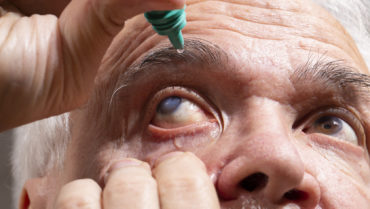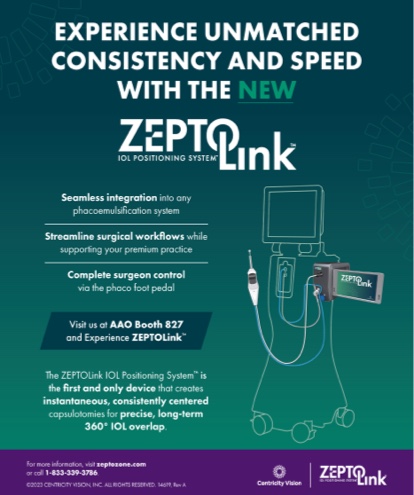What is your standard pre- and postoperative medication regimen for cataract surgery?

John P. Berdahl, MD
"Preoperatively, we don't treat patients with any topical medications to prepare them for cataract surgery. They get a midazolam, ketamine, and ondansetron melt (MKO Melt, ImprimisRx) for sedation. During surgery, we routinely use phenylephrine and ketorolac intraocular solution (Omidria, Rayner) and an injection of dexamethasone, moxifloxacin, and ketorolac in the anterior chamber and subconjunctivally. Postoperatively, patients use a once-a-day combination medication of prednisolone, moxifloxacin, and bromfenac for 1 month.”

James A. Davison, MD, FACS
"My medication routine before and after surgery has remained fairly constant for many years. The program of antibiotic, steroid, and NSAIDs is based on ease of use, effectiveness, and cost. We add 0.3 mL of 1:1,000 epinephrine to 500 mL balanced salt solution for irrigation and intracameral lidophen at the beginning of surgery and moxifloxacin 0.5% ophthalmic solution (Vigamox, Alcon) at its conclusion.
My standard preoperative medication regimen is one drop of Vigamox three times daily for 2 days before surgery. My standard postoperative medication regimen is as follows:
One drop Vigamox three times daily for 2 days, including the day of surgery;
One drop Prolensa (bromfenac sodium 0.07%; Bausch + Lomb) nightly for 1 week, including the day of surgery; and
One drop prednisolone acetate 1% three times daily for 3 weeks, including the day of surgery.”

Cynthia Matossian, MD, FACS
"First, I look for, diagnose, treat, and educate the patient about preexisting dry eye, ocular surface, or lid margin disease. If any is present, I aggressively tune up the ocular surface (click here for details on my approach to optimizing the cornea before cataract surgery). Then, the patient is brought back for presurgical measurements with more reliable data to calculate IOL powers and plan for astigmatism management.
Three days before surgery, patients are started on antibiotic and NSAID drops twice daily. This helps train the patient on drop instillation. Even though we may think it’s easy to deliver a drop from an upside-down bottle while squeezing, it is not always intuitive for patients. Many struggle to successfully get a drop to land on the cornea. There is a definite learning curve. The NSAID helps maintain pupil dilation during surgery while proactively addressing the inflammatory cascade that is about to ensue from the surgery.
Omidria during surgery has been a staple for me since it became available. Bathing the eye with ketorolac and phenylephrine via the irrigating solution helps maintain pupil dilation, creates a more stable iris diaphragm, and controls inflammation. In an analysis that I completed a few years ago, I found that my need for pupil dilation devices dropped significantly, and my surgical time decreased with Omidria on board.
Postoperative drops are confusing to both patients and their caregivers. The typical triple cocktail of an antibiotic, NSAID, and steroid drops over multiple weeks and, for the steroid, in a tapered fashion, leads to decreased patient satisfaction with the surgical journey. Instead of focusing on the 10-minute procedure and the terrific visual outcome, patients complain about the never-ending drop protocol. My go-to regimen is the instillation of dexamethasone intraocular suspension 9% (Dexycu, ImprimisRx/EyePoint Pharmaceuticals) under the iris through the sideport incision after all OVD has been properly removed and the main incision has been well sealed. Once the spherule is tucked in the sulcus, I inject compounded moxifloxacin (purchased from either ImprimisRx or OSRX) into the anterior chamber through the sideport incision and then hydrate the wound for closure. This ensures that both a steroid at the target tissue for inflammation control and an antibiotic are within the eye during the immediate postoperative period.
In my experience, patients do not mind using a single NSAID drop daily for 4 to 6 weeks postoperatively (the duration depends on if there is a history of macular pathology). Minimizing the drop burden while utilizing FDA-approved steroid products designed for postoperative inflammation control is a win-win for our patients and for innovation in our field.”
1. Witkin AJ, Chang DF, Jumper MJ, et al. Vancomycin-associated hemorrhagic occlusive retinal vasculitis. Ophthalmology. 2017;124(5):583-595.

Brett Mueller, DO, PhD
"“When I try to assess my pre- and postoperative medication regimen for cataract surgery, my goals are to keep it simple and to minimize the number of drops for the patient. I firmly believe that patients who are on a lot of postoperative drops are most likely not taking them correctly. I have tried many different pre- and postoperative drop regimens, and I find my current system to be the most effective and easiest for patients.
First, I do not use any preoperative drops. I have in the past, but I feel that the scientific data have demonstrated that there is no benefit in the utilization of drops before cataract surgery.
Intraoperatively, I place a small amount of intracameral triamcinolone-moxifloxacin PF (15/1 mg/mL; Tri-Moxi, ImprimisRx), which is available in single-use vials. I also perform sub-Tenon injections of Tri-Moxi and then quickly irrigate the intracameral injection out of the eye. Postoperatively, I have patients administer one drop of prednisolone phosphate 1%/moxifloxacin 0.5%/bromfenac 0.075% (OSRX) daily for 30 days (standard patients) or 45 days (patients who require an extended taper).
For patients with glaucoma and other patients in whom I do not administer a sub-Tenon injection of intracameral Tri-Moxi, I deliver an intracameral injection of PF moxifloxacin and then have them administer a weekly tapering dose of 4-3-2-1 drops per day for 4 weeks of prednisolone phosphate 1%/moxifloxacin 0.5%/bromfenac 0.075%.”

Maria C. Scott, MD
"The primary goal to achieve with pre- and postoperative medication regimens for cataract surgery is to prevent infection and reduce inflammation and pain. Secondary goals are to simplify the regimen to increase compliance and decrease the cost to the patients.
In the past, I used three brand-name drops in my medication regimen: a fourth-generation fluoroquinolone, a steroid, and an NSAID. This regimen was confusing and expensive for patients, even when they had insurance coverage, and our schedulers were inundated with preauthorizations and denials from insurance companies.
I trialed Dexycu, but I found an increase in rebound inflammation, corneal edema, and cystoid macular edema with its use and encountered difficulty in that not all insurance plans covered it. I switched to sub-Tenon Kenalog (triamcinolone acetonide; Bristol-Myers Squibb) and found an improvement in rebound iritis and corneal edema but still experienced an increase in cystoid macular edema. My final switch to date occurred several years ago when I started using compounded drops from OSRX.
Today, my preoperative regimen is one drop of mydriacyl/phenylephrine (OSRX) and one drop of a combination drop of bromfenac, moxifloxacin, and prednisone phosphate administered twice. After treatment with a femtosecond laser, a drop of ketorolac is instilled, which helps prevent miosis. The patient receives a Betadine (povidone-iodine; Avrio Health) prep with dilute Betadine, and moxifloxacin/dexamethasone is placed directly on the eye before the case begins.
During surgery, Omidria is used in the bag. All patients taking tamsulosin who have small pupils get an injection of epinephrine and the Omidria solution at the beginning of the case. At the end, a combination of preservative-free moxifloxacin and dexamethasone (OSRX) is injected into the anterior chamber. One drop of the same combination is placed on the eye with a drop of dilute povidone-iodine and a small amount of Viscoat (Alcon).
Postoperatively, patients use the combination drop of moxifloxacin, bromfenac, and prednisolone phosphate three times per day for 1 week and once per day for 3 weeks. The cost to the patient is less than prescription drops at the pharmacy, and the ease is appreciated by the patients. Also, the combination drop provides coverage against keratitis from limbal relaxing incisions.”




